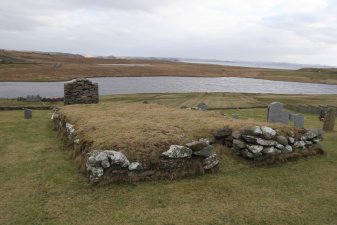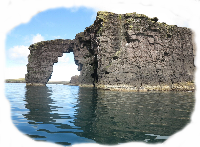


There is an 1880 survey map showing the West Ayre at Hillswick as the site of the St Magnus Chapel and burial ground, certainly there are records of human bones having been found in that area and there was a midden, from which many years ago shells and the bones of birds and animals were sent to Edinburgh Museum.
But the kirk that preceded the present St Magnus Church stood in the old Hillswick kirk yard and is thought to have been built on the site of a 'Pictish' broch. In the Statistical Account this kirk is said to have been rebuilt in 1733 and then repaired in 1764. It was designed with an outside staircase that was used to reach the gallery and the roof was thatched.
In 1870, four long-handled weaving combs, made from bone were found in a midden nearby and are in the National Museum in Edinburgh.
A small 14th century Scandinavian scale-weight of a bronze pony was also found here. The only other mention of religious buildings in this area refers to a monastery on Hillswick Ness.
Norse is still obvious in this area, not so much from archaeology, as from the culture that is still evident in the small hamlets around the parish, for instance where hill dykes remain.
Some wonder at the lack of height or their ability to contain sheep. A theory given is that at one time they were indeed stock-proof and the extra height was gained by building turf on top of the stones. The practice of marking the ears of sheep dates from this Norse period, when flocks grazed on unfenced scattald. Each crofter had his own mark registered with the great foude, he was the magistrate who had direct authority from Shetland and Norway's king.
Another example of the continued Norse influence is the number of folk still using boat noosts, although this is declining here, with less Shetland models being used and more speed boats with heavy engines being moored off in the voe during the summer months and then taken away on trailers in the winter. Two Norse tools still surviving and in use on most crofts, are the Shetland spade, designed for working in shallow soil with a four foot wooden handle, an iron shoe and it had a step to push it into the ground with the foot. The other tool was the tushkar, a tool used to cut out slabs of peat to be dried for fuel.

Another kirk of interest is the Cross Kirk at Brecon in Eshaness, a pre-Reformation chapel. Fearing that it was being used for superstitious rites by the locals, it was razed to the ground by Hercules Sinclair the minister at the time, afterwards he considered the people of this area to be more civilised.
The oblong foundation of the Cross Kirk, with the wall at places standing over a metre high, can still be seen in the churchyard, as seen on the left.


A large flat slab of stone known as the RUNE STONE is believed to have come from this kirk and although virtually illegible now, was thought to be quite important because of the inscription using Latin and Rune among the symbols. The slab can be seen nearby lying on top of Johnnie Notion's grave. The pictures opposite shows sections of the stone using special lighting to read the surviving text.
